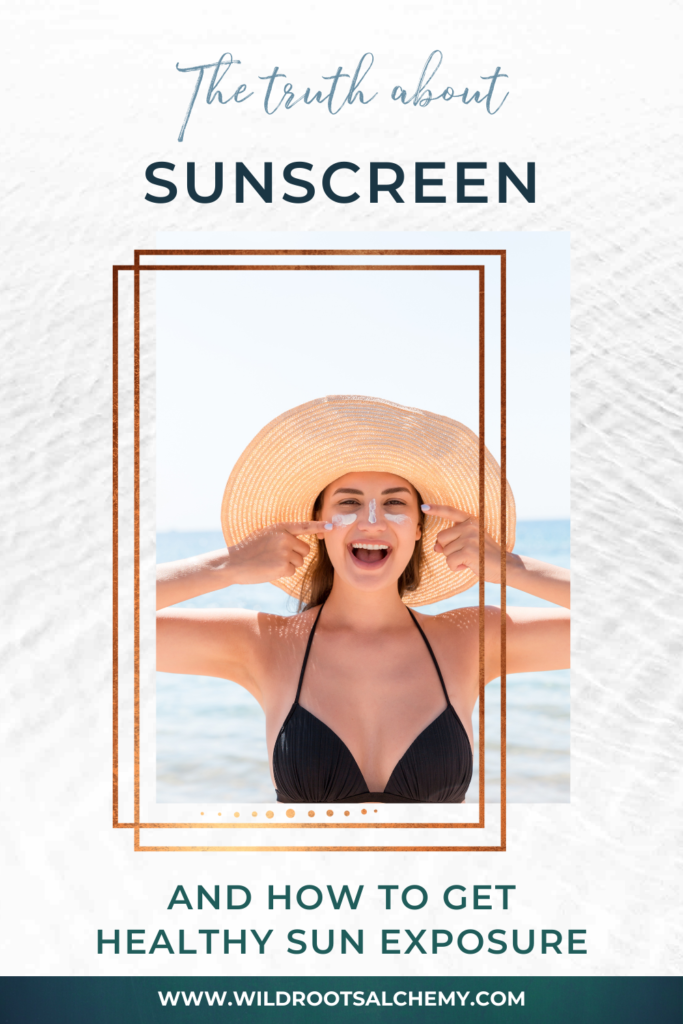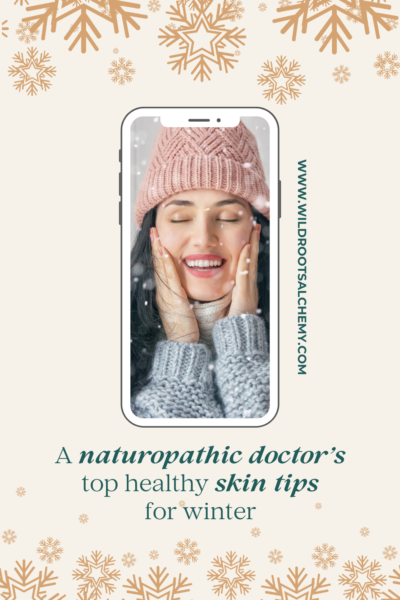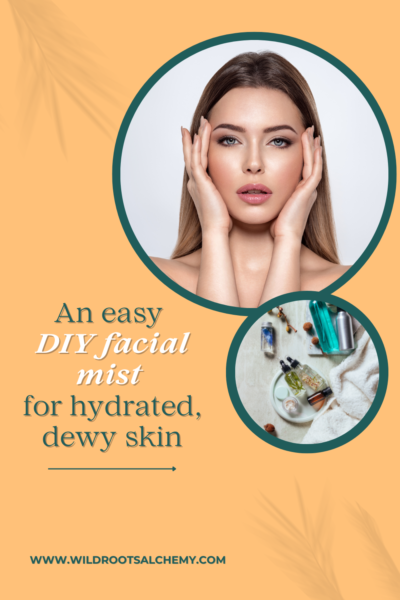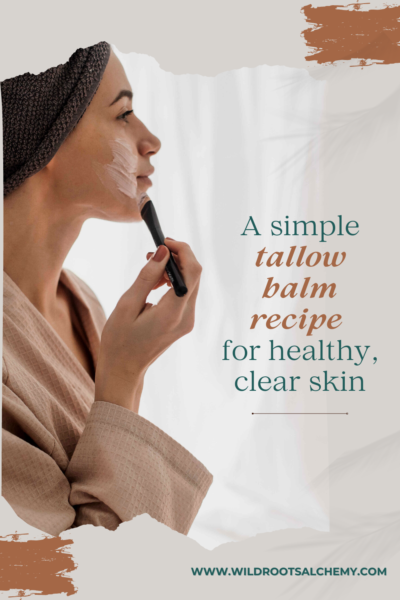
The sun is what makes life on Earth possible. We can all feel the invigorating, health-promoting effects of sunshine every time we step outside on a sunny day.
Yet for a long time now, we’ve been taught to fear the sun and it’s life-giving rays.
In fact, the American Academy of Dermatology says that there is absolutely no safe amount of sun exposure. They continue to say that sun exposure is dangerous and that we should slather on sunscreen every time we go outside, cover up our skin, and stay in the shade.
How is sunlight—which is necessary for all life on Earth—somehow dangerous only to humans? Plants need sunlight for photosynthesis, and you don’t see animals applying SPF every two hours. Yet somehow we’ve been conditioned that human beings are the only species on Earth that haven’t evolved to handle the sun.
Disease manifests when we’re living out of alignment with Nature, and same goes for our ability to protect ourselves from the sun’s UV rays. Deep down, does completely avoiding the sun resonate with you? Does the statement “Any amount of sun exposure is harmful” make intuitive sense to you, when you know that we’ve evolved as a species who, until recently, spent most of their time outdoors?
Interestingly enough, skin cancer rates are rising dramatically, even though people are spending more time indoors than ever before. So there’s something else that’s contributing to skin cancer than just sun exposure or a lack of SPF, given that we spend far less time outside in the sunlight and apply far more SPF than previous generations.
Please note: The topic of SPF and UV radiation isn’t black and white. Sunlight certainly can lead to skin damage and skin cancer, but we have innate protective mechanisms that have recently gone awry for a variety of reasons, thus protecting yourself is far more nuanced than just avoiding the sun and applying SPF. In fact, those very things could be contributing to a higher risk of skin cancer, which we’ll discuss in this article.
The risks of not getting enough sun exposure
The problem with avoiding the sun is that a lack of sun exposure has been associated with vitamin D deficiency, increased prevalence of mood disorders, increased rates of certain cancers, and increased rates of certain diseases (including cardiovascular disease). And unfortunately, simply taking supplemental vitamin D doesn’t afford the same benefits as naturally-derived vitamin D.
This 2016 scientific review discusses the abundant health benefits from sun exposure, including the prevention of various cancers, cardiovascular disease, Alzheimer’s disease, eye disorders, mood disorders like depression, type 2 diabetes, and other chronic diseases.
Sunlight plays an important role in your health, mainly by:
- optimizing vitamin D production, a hormone that is essential for a number of processes in your body, including immune health, bone health, cardiovascular health, and hormonal balance
- regulating your circadian rhythm
- promoting healthy serotonin levels
- alleviating stress and promoting a good mood
Due to all these benefits, the authors of this paper urge that the nearly universal message of sun avoidance be changed to getting regular non-burning sun exposure sufficient to obtain serum vitamin D (25-OH) concentrations of 30 ng/mL or greater in the sunny months and to get the other benefits of UV exposure aside from vitamin D production.
While sun exposure in excess can certainly be harmful (sunburns are never a good thing), we all need safe, uninhibited sun exposure as often as possible.
The risks of sun avoidance and sunscreen use
We’ve been led to believe that all sun exposure equates to increased skin cancer risk and that liberal use of sunscreen will protect us all from skin cancer. Unfortunately, the scientific research doesn’t support this, despite what most doctors, the FDA, and most health organizations preach.
In fact, there are many studies that suggest that sun avoidance and regular sunscreen use may actually do more harm than good.
This isn’t to say that sun damage doesn’t occur or that UV light can’t be harmful. Just like anything, it’s all about dose: too much sun can lead to sunburn, which is damaging to your skin. However, there is no good data to show that non-burning sun exposure increases the risk of skin damage and skin cancer.
If malignant melanoma rates are increasing in the United States by about 3% every year despite increased sun avoidance and sunscreen use, this tells us that there is likely something else that is contributing to the increase in cancer cases. Additionally, there is current little evidence that sunscreens are protective against melanoma; and in fact (according to a 2006 US Environmental Protection Agency publication), a number of studies suggest that regular sunscreen use may actually increase the risk of melanoma.
The number of malignant melanoma cases is increasing among indoor workers who get 3-9 times less sun exposure than outdoor workers. There’s also a higher incidence of melanoma among white people living in northern states such as Delaware and Vermont (>30 cases per 100,000), who receive less year-round sunshine than southern states such as Texas and Florida (<25 per 100,000 people). This points to other factors besides sun exposure that are contributing to skin cancer risk.
Interestingly enough, there are a few studies that show that regular, moderate exposure to sunlight may actually be protective against melanoma. In one study, those with regular non-burning sun exposure had a reduced incidence of melanoma compared to those who enjoyed recreational sun exposure (and likely got burnt).
The increased risk of melanoma in those that use sunscreen may be due to the active SPF ingredients (more on that later) as well as due to the observation that those who wear sunscreen may spend longer out in the sun than those who don’t. That’s because sunscreen protects against sunburn without blocking out all of the sun’s rays, which can lead to a false sense of protection and more time spent out in direct sunlight, leading to a greater risk of sunburns, sun damage, and skin cancer.
While sunscreens can protect against sunburn, this doesn’t stop certain types of UV light from entering the skin.
Types of UV light: UVA, UVB, and UVC
Ultraviolet (UV) light from the sun is made up of UVA, UVB, and UVC light. When it comes to sun exposure, we’re concerned with UVA and UVB light, as UVC is filtered out by the Earth’s outer atmosphere.
UVB light penetrates the outer layer of the skin (epidermis) and is responsible for vitamin D production, while UVA light does not stimulate vitamin D. When the skin doesn’t have supportive defense mechanisms in place, UVB light can lead to DNA damage at the cellular level, contributing to skin damage, sunburn, and skin cancer.
UVA light, on the other hand, can penetrate deeper into the skin. It can indirectly lead to DNA damage by creating free radicals and oxidative stress, and this can be especially harmful if your body doesn’t have the resources to clean up the mess and prevent oxidative damage. UVA rays are the ones associated with skin aging; again, likely due to oxidative stress in the absence of your innate protective mechanisms. (The theory is that if your innate protective mechanisms are top-notch, these rays will not lead to damage and increased skin aging.)
It was long thought that UVB light was the primary cause of all skin cancers because it can directly damage DNA; however, recent studies have suggested that UVA radiation plays a bigger role in the development of melanoma than UVB light.
Most sunscreens only block out UVB, with little to no protection against UVA radiation. So when you see an SPF (sun protection factor) number, this only relates to how well the sunscreen protects against UVB, not UVA. The most effective sunscreen against UVA is titanium dioxide, a physical sunscreen, yet it only blocks out 25% of UVA rays.
So while sunscreens may protect you from UVB radiation and thus getting burnt, you may be getting over-exposed to UVA radiation and increasing your risk of melanoma.
A note on tanning beds: Tanning beds emit far stronger UVA radiation than natural sunlight with smaller doses of UVB. So while you are less likely to burn with tanning beds, they’re doing far more damage to the deeper layers of your skin, which increases your risk of developing melanoma.
Why the sun isn’t the problem: The real causes of sun damage
As human beings, we’ve evolved in a symbiotic relationship with the sun, the Earth, and all living beings around us. It would make sense then that we need sunlight to be healthy, and that along our evolutionary path, we’ve developed mechanisms to prevent damage from excessive sun exposure.
A suntan is when the body produces melanin, making the skin darker. This is the body’s defense mechanism against sunburn and sun damage. When the melanocytes in your skin can’t keep up with melanin production, this is when sunburn and sun damage occur.
Those with a conventional perspective on sun exposure would argue that a suntan is the first sign of sun damage. However, a suntan is not the same as a sunburn, and there is no good evidence that non-burning sun exposure increases the risk of skin damage and skin cancer.
That isn’t to say that excessive tanning is good, either. Sun damage is all about cumulative exposure and is dose-dependent. Tanning means that your body is trying to defend itself against damage, and therefore increased tanning correlates with an increase in skin damage.
But a suntan is a natural mechanism by your body to prevent sun damage, and if this mechanism is intact and functioning well, your risk of skin cancer is likely low (based on the available research). The problem arises when your body isn’t able to defend itself in the sunlight, and there are many reasons for why that is the case.
Reasons why your body may not be able to adequately protect itself against sunlight (and how to optimize your body’s innate protective mechanisms)
An inflammatory, nutrient-poor diet
An inflammatory diet that’s high in processed foods, inflammatory fats (trans fats and omega 6-rich vegetable oils), and sugar creates oxidative stress in your body, and your body is going to naturally try to put out your internal “fires” and protect your vital organs than try to use its precious antioxidants on your skin. An inflammatory diet is also often deficient in phytonutrients that serve as antioxidants in your body, which protect your skin from UV radiation and free radical damage.
Support your body’s ability to protect itself from UV radiation by eating a nutrient-dense diet full of colorful fruits and vegetables, which are high in antioxidants and can help prevent sunburn and skin damage. Antioxidants include dietary polyphenols (found in fruits and vegetables, tea, and dark chocolate), carotenoids (i.e. vitamin A, astaxanthin, lutein, lycopene, zeaxanthin), vitamin C, and vitamin E.
Immune system dysregulation
Your immune system is responsible for modulating your skin’s response to sunlight. If your immune system isn’t up to par, your body is less able to defend itself and repair any skin damage. Most Americans are immune-compromised to some extent, given the prevalence of metabolic dysfunction (up to 88% of American adults in one study) and how this disrupts the health of the immune system. Metabolic dysfunction is primarily due to a lack of exercise, eating a poor diet, and stress, so optimize your metabolic health to optimize your sun protection.
Certain medications, supplements, and topical products
Many medications increase your skin’s sensitivity to sunlight. These include certain antibiotics, antihistamines, statins, NSAIDs like ibuprofen, and Accutane/isotretinoin (an acne medication). St. John’s Wort is a common herb that can cause sun sensitivity when taken orally. Topical skincare products often used by those with acne can increase the risk of sun damage, including retinoids, alpha and beta hydroxy acids like glycolic acid and salicylic acid, and benzoyl peroxide.
The role our Earth plays in protecting us from UV radiation
The ozone layer of our Earth’s atmosphere is our planet’s sunscreen: it helps protect us and all life here on Earth from excessive UV radiation. However, this layer is getting depleted at an alarming rate, which affects how well the Earth’s atmosphere is able to absorb UV rays and protect us from their harmful effects.
A depleted ozone means that more UV radiation is making its way through the atmosphere and to our skin. So in essence, this means that the sun’s rays affect us more strongly than ever before, and we have yet to fully adapt.
However, our bodies are learning how to adapt. Just like with unnatural EMFs, electricity, pollutants, and other man-made changes that are negatively affecting the health of our planet and all of life, our bodies are actively learning how to be resilient despite living out of alignment with Nature.
How to get healthy sun exposure
- First and foremost, don’t allow your skin to redden or burn. Seek shade or cover up your skin at the first sign of skin pinkness, or if you get uncomfortable or hot.
- Get 15-20 minutes of sun exposure in the morning before 10AM, ideally within the first hour after waking. Get another 15-20 minutes of sun exposure in the evening right before the sun sets. This helps regulate your circadian rhythm.
- Sunlight exposure to your eyes is just as important as to your skin, so keep your sunglasses off if possible (at least for the morning and evening sunlight) while trying to avoid squinting.
- Vitamin D production is highest when the sun is highest in the sky (between 10AM-2PM); however, the sun’s UVB rays are strongest at this time and there is a higher risk of burning. Take care during this time not to burn. It’s important to note that the sun’s UVA rays are strongest in the earlier and later parts of the day, so while you’re less likely to burn, your skin may be more exposed to melanoma-promoting UVA rays during this time.
- Get at least 5 minutes of uninhibited sun exposure every day. Slowly work up your tolerance over time. You do not want to burn, as this means your skin has been damaged by the sun.
- If you know that you’re going to be in the sun longer than your skin can tolerate or if it’s mid-day when the sun’s rays are the strongest, do the following:
- Seek shade as often as possible, especially when you’ve hit your sun tolerance limit (before your skin turns pink)
- Wear a hat
- Wear sun-protective clothing (long sleeves, pants)
- Apply non-toxic, mineral-based SPF to avoid burning
- Remember that it’s not healthy or advised to spend hours upon hours directly in the sun each day without any sort of protection (i.e. hats, clothing, shade), regardless of how well your skin tolerates sunlight.
When to use SPF
In no way am I advocating against the use of sunscreen. SPF is one of our tools that can help prevent sunburns, skin damage, and certain types of skin cancer…but one of the points of this article is to emphasize that SPF is not your ONLY tool in optimizing your protection against solar UV radiation.
For those with a history of skin cancer, skin conditions that flare with sun exposure, or you have tattoos, SPF should be applied regularly, in addition to wearing hats and protective clothing. However, optimizing your body’s protective mechanisms against UV exposure can help protect against sun damage as well (see paragraph above titled: “Reasons why your body may not be able to adequately protect itself against sunlight (and how to optimize your body’s innate protective mechanisms)”).
If you’re using skincare products or topical acne medications that contain retinoids (like tretinoin or adapalene), alpha/beta hydroxy acids (like glycolic acid or salicylic acid), or benzoyl peroxide, you want to make sure you’re applying sunscreen daily, as these ingredients increase your skin’s sensitivity to sunlight. Similarly, certain herbs and medications can reduce your skin’s ability to protect itself against UV radiation, so make sure you speak to your doctor about proper sun protection if you’re taking any medications or supplements.
For everyone else, non-toxic mineral-based SPF should be used when you’re spending more than 30 minutes outdoors at a time or you’ve reached your daily sun exposure limit, which will be different for everyone.
Choosing SPF wisely
Unfortunately, sunscreen blocks some of the sun’s benefits, possibly including optimal vitamin D production. (Please note: There is controversy about whether or not vitamin D production is blocked by SPF. Theoretically, blocking UVB radiation would block the stimulation of vitamin D production; yet, several studies show that this is not the case. However, some of these studies admit that the thickness of SPF application can affect whether or not this inhibits vitamin D production, and the researchers even stated that the results showing equal vitamin D production between the no-sunscreen and sunscreen groups was in part due to the “the lack of total skin cover at all times.”* This brings up the question if they are even getting enough UV protection in the first place.)
The goal, then, is to get enough sunlight exposure every day for its benefits (such as adequate vitamin D), while also taking care not to burn and damage your skin. This means that protection in the form of SPF can be necessary and helpful, but it’s important to choose SPF wisely!
You want to avoid sunscreens that contain active chemical ingredients like oxybenzone, avobenzone, octisalate, octocrylene, homosalate, or octinoxate. Unfortunately, these chemicals are in most sunscreens on the market!
These sunscreen ingredients are absorbed through the skin and many of them disrupt your hormones, including thyroid hormone and sex hormones like estrogen. Some of them are also known carcinogens (cancer-causing chemicals) that may actually be contributing to increased rates of skin cancer. Not only can these ingredients be harmful to us human beings, but they’re also contaminating our oceans and killing off coral reefs. (Read more about common sunscreen ingredients here.)
So far, the FDA hasn’t labeled these SPF ingredients as safe or unsafe. The FDA has said that while they know the chemical sunscreens listed above are absorbed into the body, they’re waiting on more studies to determine that they are unsafe.
In industry-speak, this typically means that while there has been concern over these ingredients (the research supports this), the FDA isn’t willing to ban them or label them unsafe because there’s a lot of money invested into these products by the pharmaceutical companies.
Currently, the only active sunscreen ingredients designated as “GRASE” (“generally recognized as safe and effective”) by the FDA are mineral-based: zinc oxide and titanium dioxide. While they are a safer alternative, these mineral-based sunscreens also tend to offer slightly more UVA protection than conventional chemical sunscreens.
When looking for SPF, opt for mineral-based sunscreens: those that contain either zinc oxide or titanium dioxide as an active ingredient. (However, I highly recommend using zinc oxide over titanium dioxide given that titanium acts more like a heavy metal in the body.) It’s also important to find a mineral-based SPF that doesn’t use nanoparticles, as these can be harmful. The label should ideally say “non-nanoparticle.” This facial sunscreen by Juice Beauty is a good mineral-based SPF made with zinc oxide, plus it’s tinted (which I like!).
Want to see if you’re getting enough vitamin D?
The DMinder app is a simple way to keep track of your daily vitamin D production. It’s also a helpful reminder to go spend more time outside in nature!
Interested in learning more about healthy sun exposure and vitamin D?
Dr. Stephanie Seneff has done an incredible amount of research into vitamin D and sunlight. Click here to read this insightful article of hers.
Disclaimer: Some of the links to products in this article are affiliate links. I make a small commission off of the sale at no additional cost to you. Thank you for helping to support my small business!





